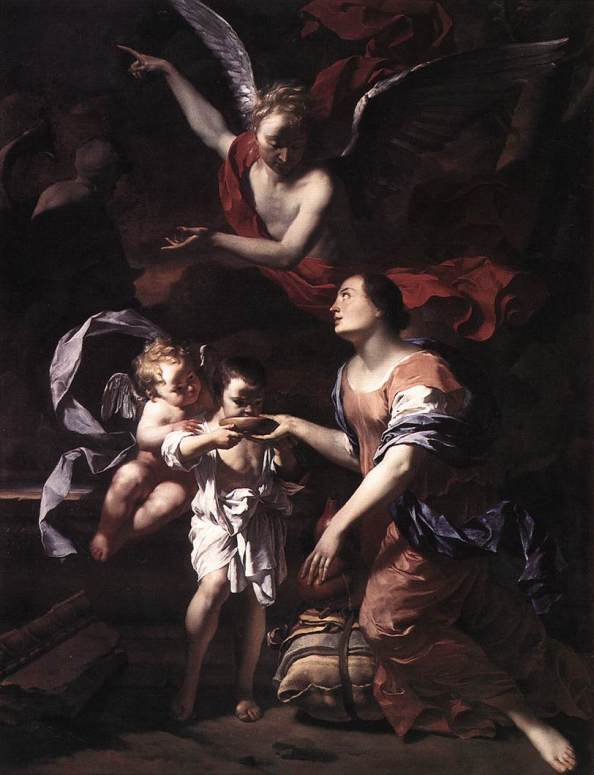As the Jewish version of the story (which Christians have adopted and the only one I was aware of until recent years) goes, Sarah gives her servant, Hagar, to Abraham to fulfill God’s promise that Abraham would become the father of many nations, something Sara assumes to be impossible through her, an old woman. Hagar has Ishmael and then Sarah, despite her old age, has Isaac. That, as might be expected, generates some jealousy. Genesis 21:1-21 tells the story that Sarah made it clear to Abraham that Abraham’s son, Ishmael, by her servant, Hagar, was not going to compete with Abraham’s son by Sarah, Isaac; and so, she demands of Abraham: Hagar and Ishmael must go. The Jewish account, of course, suggests that their own claimed ancestor, Isaac, was the one who God had really intended as heir to Abraham, and that Sarah short circuited the process for lack of faith. The underlying notion of that story is that Ishmael is the ancestor of other non-Jewish inhabitants of that region, most often perceived by Jews to be their enemies. Nonetheless, the story does concede that God promised to make of Abraham the father of many nations. The biblical story concedes that for Abraham, both Ishmael and Isaac were equally his sons, that he loved each of them, and that he was very much grieved and conflicted over Sarah’s demand. The story is fascinating for me, both for its expansive and inclusive view of who are “God’s children,” and for the narrow views that have nonetheless been slipped into it. Perhaps that is an inevitable part of the human condition. Or is it inevitable?
One aspect of the story that strikes me is that, after all, we are family: every one of us is a child of God. A corollary might be that there is no such rancor and emotionally toxic byproducts of any feud as with family: such conflicts strike too close to home to be seen objectively.
Here are various aspects of the story as seen through artists’ eyes.

Abraham and Hagar MOSTAERT (c 1474 – 1555/56)
See http://www.wga.hu/frames-e.html?/html/m/mostaert/jan/abraham.html for the source of the above photograph of the painting and some notes. You will notice that, as with the biblical scenes of Ghiberti, the painting is not of a single scene at a particular time but is a composite of different scenes and events at different times; also it is cast in the time and style familiar to the artist. In the background you see the angel protecting Hagar and Ishmael in their wilderness journey that follows. Perhaps Abraham’s gesture shows his love for Hagar and Ishmael and his reluctance to see them go. You may see other symbols or expressions as well. Good art, it seems, not only expresses the artist’s conscious intentions but taps into both universal experiences of life, even of transcendence, and the particular experiences of the observer. Good art, in all its forms of expression, invites the observer or listener into it and to participate.

Abraham Casting Out Hagar and Ishmael GUERCINO (1591-1666)
See http://www.wga.hu/frames-e.html?/html/g/guercino/2/abraham.html for the source of the photograph of the painting and notes. Whereas Mostaert treats the subject of his painting largely as a narrative story, providing an opportunity to paint a scenic view, Guercino explores the human, emotional side of the story from the point of view of each of the subjects. Now that provides an interesting study of character and of the conflicts inherent in living and doing “what one must do” to get along.

Hagar and Ishmael Banished by Abraham VERHAGHEN (1728-1811)
See http://www.wga.hu/frames-e.html?/html/v/verhaghe/hagar_is.html for the source of the photograph of the painting and notes. This painting also seems to me to be a study in characters and their perspectives. Ishhmael looks to Isaac, who seems to want his brother and friend to stay, as Sarah restrains Isaac to protect him from some childish indiscretion. Hagar is stoic, almost contemptuous, and Abraham is conflicted, looking to Hagar as he apparently places his right hand on Hagar’s back, perhaps affectionately, as he motions her way out, obedient to Sarah’s demand.
And finally,

The Expulsion of Hagar CLAUDE (1600-1682)
See http://www.wga.hu/frames-e.html?/html/c/claude/3/06hagar.html for the source of the photograph of this painting and notes. I have included this, not because it says anything significant to me, but because it reflects one aspect of humanity that simply wants a feel-good moment in religion, or a religious story or rite that offers us an opportunity for entertainment or to perform, or confirms the imagined validity of our delusions. Perhaps there is a place for that. Certainly, not all our religious experiences must be “deep” or serious.
Links to my site:
Introduction
https://bibleartists.wordpress.com/2013/07/14/introduction/
Graphic Arts
https://bibleartists.wordpress.com/2013/07/14/i-graphic-arts/
Architecture
https://bibleartists.wordpress.com/2013/07/14/ii-church-architecture-and-its-incorporation-of-art/
Music
https://bibleartists.wordpress.com/2013/07/14/iii-music/
Theology
https://bibleartists.wordpress.com/2013/07/14/iv-theology/
Home Page
https://bibleartists.wordpress.com/






